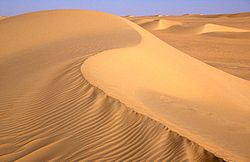Tenere Desert
|
Ténéré Tiniri |
|
|---|---|
| Desert | |

|
|
 Map of the Ténéré - Aïr Natural Reserve area. |
|
| Countries | Niger and Chad |
| Area | |
| • Total | 400,000 km2 (200,000 sq mi) |
| Elevation | 430 m (1,410 ft) |
The Ténéré (Berber: Tiniri, literally: desert, wilderness) is a desert region in the south central Sahara. It comprises a vast plain of sand stretching from northeastern Niger into western Chad, occupying an area of over 400,000 square kilometres (150,000 sq mi). The Ténéré's boundaries are said to be the Aïr Mountains in the west, the Hoggar Mountains in the north, the Djado Plateau in the northeast, the Tibesti Mountains in the east, and the basin of Lake Chad in the south. The central part of the desert, the Erg du Bilma, is centred at approximately 17°35′N 10°55′E / 17.583°N 10.917°E. It is the locus of the prehistoric Tenerian culture.
The name Ténéré comes from the Tuareg language, meaning "desert", in much the same way that the Arabic word for "desert", Sahara, came to be applied to the region as a whole.
The Ténéré has a hot desert climate (Köppen climate classification BWh), typical of the large Sahara Desert. The climate is hyper-arid, extremely hot, sunny and dry year-round and there is virtually no plant life. The average high temperatures are above 40 °C (104 °F) for about 5 months and more in the hottest regions, and record high temperatures as high as 50 °C (122 °F) are highly possible during summer. The annual average high temperature is around 35 °C (95 °F) and even more. During "winter" months, the average high temperatures stay above 25 °C (77 °F) and generally hover around 30 °C (86 °F). The annual precipitation amount is extremely low—one of the lowest annual rainfall amounts found on Earth—around 10 mm (0.39 in) to 15 mm (0.59 in), and frequently several years may pass without seeing any rainfall at all. Water is notoriously difficult to find, even underground, and wells may be hundreds of miles apart. The sunshine duration is also one of the highest results on the planet at around 4,000 hours, that is about 91% of the daylight hours between sunrise and sunset. Fair weather is nearly non-stop in this bone-dry region. This part of the Sahara Desert has one of the harshest climates in the world. According to a NASA study, the sunniest spot in the world would be a ruined fort in Agadem in the southeastern Ténéré where the solar energy productivity would be unmatched, as this desert area sees even fewer clouds than the rest of the world. The Ténéré, as well as the rest of the Great Desert, is among the most extreme environments on Earth.
...
Wikipedia
